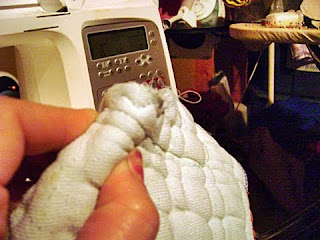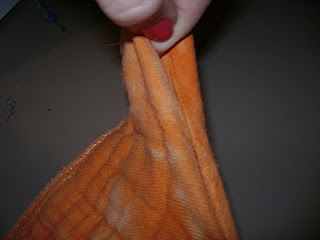In the spirit of the Jedi, I’ve decided to start my blog with a sequel first. The “No Serger Required Prefitted” tutorial was published on Diaper swappers craft chat sub forum on March 10, 2008. With 42,112 views it’s quite a long running thread full of questions, answers, modifications and love. As we near the 2nd anniversary of The “No Serger Required Prefitted” tutorial, I have a bigger and better prefitted to offer you.
No Serger Required Prefitted – The Sequel:
The Stay Dry Stuffable
This is a very quick and easy project suitable for beginner sewers. I’ve included a number of variations and modifications based on feedback from the previous tutorial as well as some new ideas, like a side snapping alternative.
Let me preface these instructions with the recommendation that you make one diaper to start with. You may find you wish to make modifications based on the fit and once you cut your entire stash of prefolds, there’s no going back. So let’s get started!
Lay out your prefold. Be mindful of the rise you wish to end up with. My premium prefolds measure 18” in length and the finished rise of the prefitted is 16” which is consistent with a size large fitted. Using a diaper with the fit you like, lay the diaper on top of your prefold. Here I have a medium Darling Diaper cut I’m using as a guide.
Cut out one leg, turn it over along the other side and cut the second leg. If you are planning on making multiple prefitteds, I suggest making a template.
Put the cutouts to the side to finish later. Lay out your diaper cut on top of your fleece liner.
*note* you don’t have to use fleece as your liner; it’s just a nice stay dry option that most of us have readily available. Microfleece or Suedecloth would also be great stay dry liners and are less bulky. If you don’t wish to have the stay dry feature, you could also use flannel, hemp, bamboo fleece, velour, or a variety of other diaper fabrics.
Cut along both legs. Fold over the back side tab and cut a straight line where you would like your liner to end, allowing for a ¼” seam allowance.
Do the same for the front.
Now fold your liner in half lengthwise, matching the leg cuts. Cut the second side to match the first.
Lay your liner and prefold cut right sides together. I’ve left the front of this line a little long so I’ll have enough room to turn under later.
*Important note* One side of your leg cut will have more layers then the other. Leaving these layers intact will hinder a good leg gather! Cut those puppies out!!! Leave only four layers of fabric, two on the inside, two on the outside.
Mark the beginning and end of the elastic for the legs.
Sew the end of your elastic securely, starting ¼” in from the edge of your liner.
Affix your elastic using a zigzag stitch with the longest stitch length available. I prefer the 3 step zig zag. Stretch your elastic taunt, release just a tiny bit and sew ¼” in from the leg edge. It’s my perhaps unfounded belief that if you completely stretch the elastic as you sew, it will wear prematurely. I’m not a diaper maker by trade, but after doing many an elastic repair I suspect this is the culprit.
Check that you are happy with the leg gathers at this point.
*Useful tip* If you’re not happy with the leg gathers (likely because of the thick layers of the prefold) you can snip away some excess fabric along the outside of the zigzag stitch. Be careful not to get too close though, otherwise it will fray like crazy after a wash. If you do this you may want to go over the cut edges with some fray check just in case.
Here’s a before:
And an after:
Now reach your hand through the middle of the “tunnel” you just sewed. Grab the tabs and pull right side out.
Separate the tab fabric, two layers on each side.
Fold them each inside on themselves.
Sew together, taking care to sew close enough to the edge to catch all the layers.
Complete for all four tabs. This is what it should look like:
Fold the side of the front liner under and start to top stitch it down beginning where the elastic started. As you near the top, fold the top side under and continue topstitching along the top. As you near the second side, fold under again and continue topstitching. *note* fleece will not fray so folding it under is purely aesthetic. You can easily stitch it down flat as well.
Now the front part of your ‘pocket’ is completely enclosed.
Topstitch the sides of the back the same way, but leave the top/backside open for stuffing.
If you are using pins or snappi’s, you are done!!!!!!
If you are adding snaps, mark your snap placement. Take care to put the male sides close to the edge of the tabs so you won’t get fabric sticking up.
Snaps can be placed for either Hip snapping
Or side snapping
Finishing the soaker
Take the cutouts from the leg openings and unfold them. Trim to the size and shape you desire and finish as you wish. You can either use an overlock stitch or hem, turn and top stitch. I cheated and used the serger here because it is fast and easy. I do recommend quilting down the middle in some fashion. These inserts can wash up pretty fluffy and kind of wonky on their own!
Additional Modifications you may want to consider
If you opt for side snapping, you may find the front tabs go quite a ways around the hips. Here’s a mod for shorter tabs. Cut off the excess tab length, leaving ¼” for seam allowance.
Notch a ¼” square from the serged portion of the top of the prefold.
Tuck the 4 layers (2 and 2) inside on themselves as you did in the earlier step and stitch up!
Here’s a mod for elastic across the back:
After you’ve installed the leg elastic and turned and topstitched the tabs, mark the beginning and end of your backside elastic.
Sew in your elastic in the same manner as your legs, zigzag with a long stitch length and be sure to tack each end down very, very well. I chose to sew the liner down across the back and make the pocket opening in the front. You could also leave the elastic exposed to the inside of the pocket since the liner will be touching baby’s back, not the elastic. Keep in mind, there are a lot of layers of Birdseye on this part of prefolds, so don’t expect huge amounts of gathering.
Wasn’t that quick and easy? Here’s some action shots for more inspiration. In case you’re wondering, yes, I do clean my house multiple times a day. No it doesn’t stay that way more than 5 minutes! That’s real life. You’ll see it a lot on my blog ! :)










































Great tutorial!! And lots of pics. Very easy to follow too :)
ReplyDelete